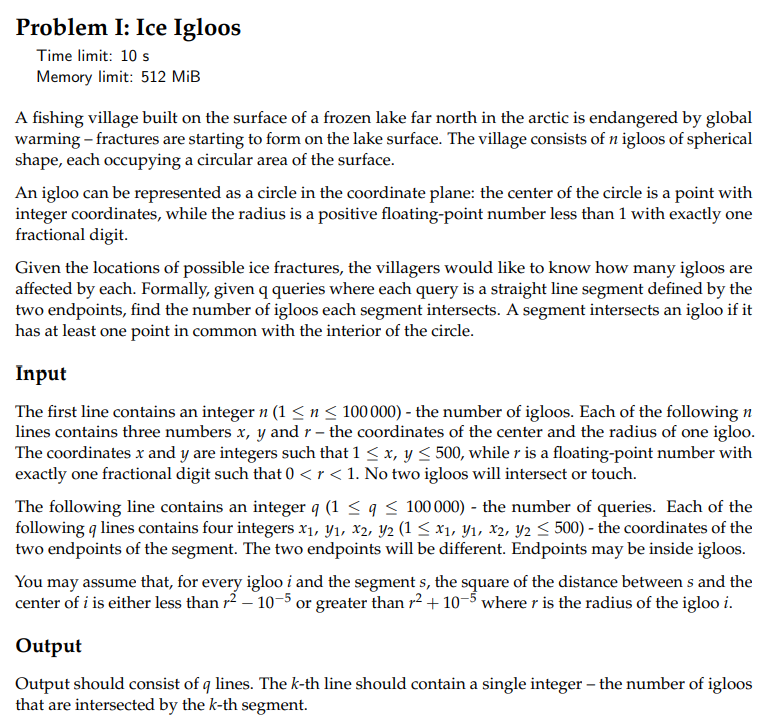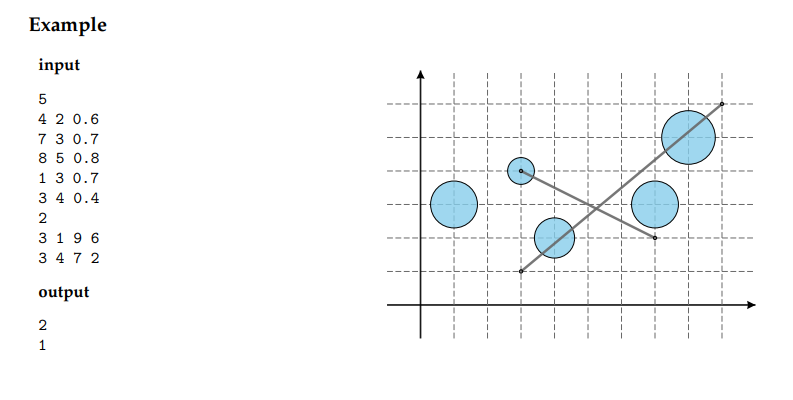洛谷 P4354 [CERC2015]Ice Igloos 题解
一、题目:


二、思路:
先考虑一个很朴素的想法,就是枚举\(500\times 500\)坐标系中的所有点,如果一个点\(P(x_0,y_0)\)上面存在着 igloo 就判断\(P\)到线段的距离是否小于 igloo 的半径,如果小于,那么就累计到答案中。时间复杂度\(O(q\times {maxx}^2)\)。
注意到题目中的一个重要性质,就是点的坐标都是整数,而且 igloo 的半径都很小。所以,可能产生贡献的点非常有限。即:只有与线段相距小于等于1的点才有可能产生贡献。所以我们只需把这些点找出来进行判断即可。时间复杂度\(O(q\times {maxx})\)。
三、代码:
#include <iostream>
#include <cstdio>
#include <cstring>
#include <cmath>
#define Vector Point
#define eps 1e-8
using namespace std;
inline int read(void) {
int x = 0, f = 1; char ch = getchar();
while (ch < '0' || ch > '9') { if (ch == '-') f = -1; ch = getchar(); }
while (ch >= '0' && ch <= '9') { x = x * 10 + ch - '0'; ch = getchar(); }
return f * x;
}
const int maxx = 505;
int n, Q;
double radius[maxx][maxx];
inline int sign(double a) {
if (a < -eps) return -1;
if (a > eps) return 1;
return 0;
}
struct Point {
double x, y;
Point() {}
Point(double _x, double _y) : x(_x), y(_y) {}
inline friend bool operator == (const Point&a, const Point&b) {
return sign(a.x - b.x) == 0 && sign(a.y - b.y) == 0;
}
inline friend Point operator - (const Point&a, const Point&b) {
return Point(a.x - b.x, a.y - b.y);
}
};
inline double get_length(Point a) {
return sqrt(a.x * a.x + a.y * a.y);
}
inline double dot(Vector a, Vector b) {
return a.x * b.x + a.y * b.y;
}
inline double cross(Vector a, Vector b) {
return a.x * b.y - b.x * a.y;
}
inline double distance_to_line(Point p, Point a, Point b) {
Vector v1 = b - a, v2 = p - a;
return fabs(cross(v1, v2) / get_length(v1));
}
inline double distance_to_segment(Point p, Point a, Point b) {
if (a == b) return get_length(p - a);
Vector v1 = b - a, v2 = p - a, v3 = p - b;
if (sign(dot(v1, v2)) < 0) return get_length(v2);
if (sign(dot(v1, v3)) > 0) return get_length(v3);
return distance_to_line(p, a, b);
}
inline void work3(int x1, int y1, int x2, int y2) {
if (x1 > x2) swap(x1, x2), swap(y1, y2);
double k = 1.0 * (y2 - y1) / (x2 - x1);
int dy = sqrt(k * k + 1) + 2, cnt = 0;
for (int i = x1; i <= x2; ++i) {
int y = (i - x1) * k + y1;
for (int j = max(y - dy, 1); j <= min(y + dy, 500); ++j) {
if (radius[i][j] > 0 && sign(distance_to_segment(Point(i, j), Point(x1, y1), Point(x2, y2)) - radius[i][j]) < 0)
++cnt;
}
}
printf("%d\n", cnt);
}
inline void work1(int x1, int x2, int y) {
if (x1 > x2) swap(x1, x2);
int cnt = 0;
for (int i = x1; i <= x2; ++i) {
if (radius[i][y] > 0) ++cnt;
}
printf("%d\n", cnt);
}
inline void work2(int y1, int y2, int x) {
if (y1 > y2) swap(y1, y2);
int cnt = 0;
for (int j = y1; j <= y2; ++j) {
if (radius[x][j] > 0) ++cnt;
}
printf("%d\n", cnt);
}
int main() {
n = read();
for (int i = 1; i <= n; ++i) {
int x = read(), y = read();
scanf("%lf", &radius[x][y]);
}
Q = read();
while (Q--) {
int x1 = read(), y1 = read(), x2 = read(), y2 = read();
if (y1 == y2) { // horizontal
work1(x1, x2, y1);
}
else if (x1 == x2) { // vertical
work2(y1, y2, x1);
}
else work3(x1, y1, x2, y2);
}
return 0;
}


